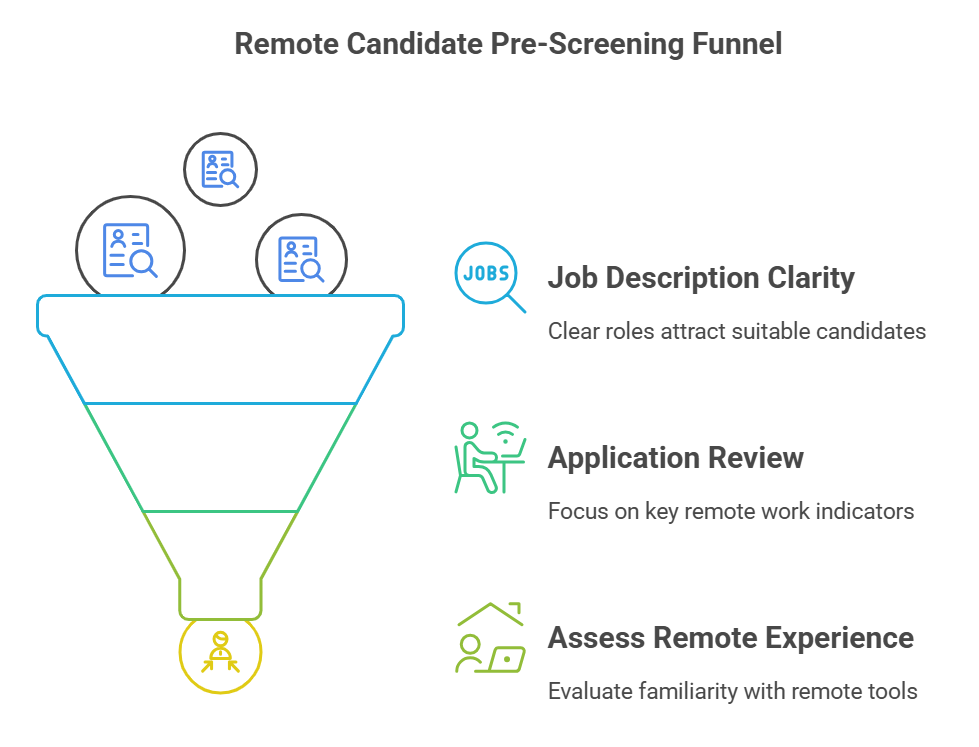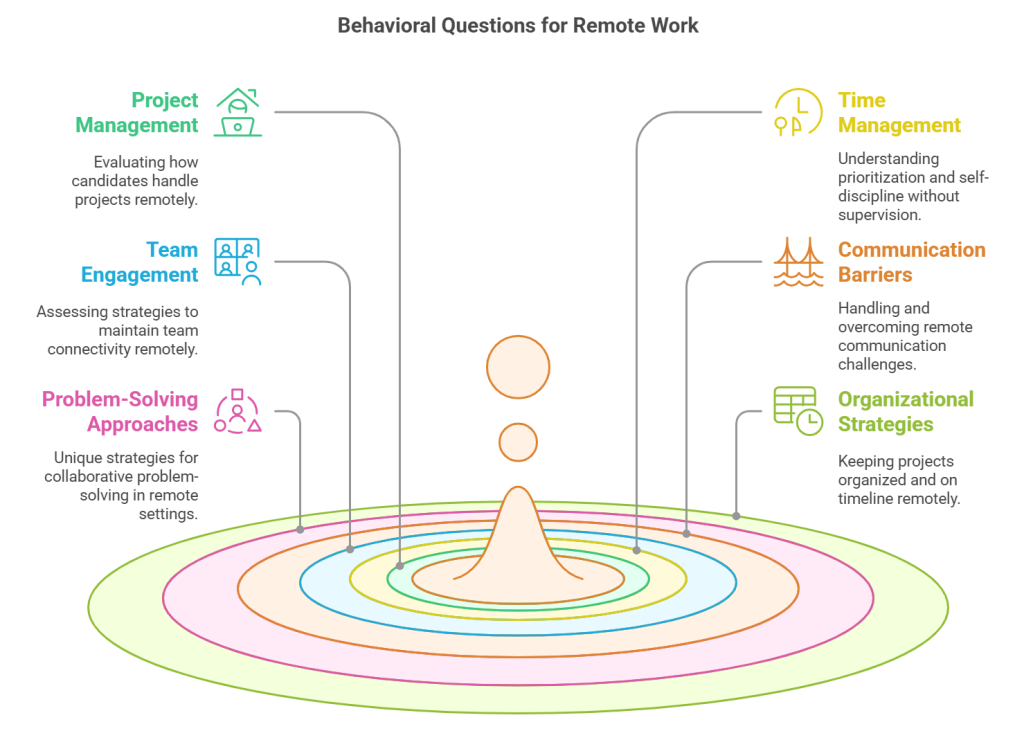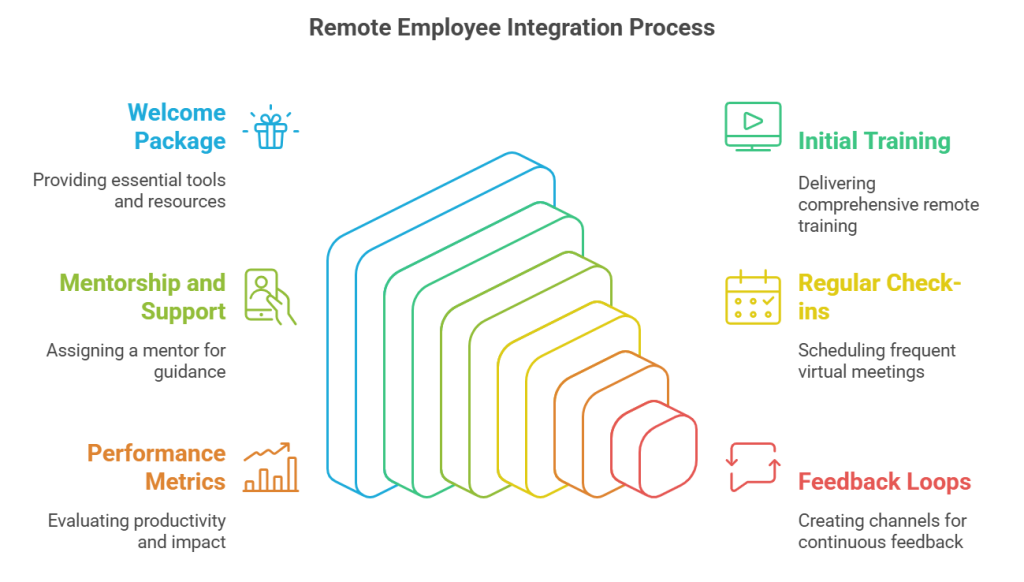As remote work becomes increasingly prevalent, the need for effective screening processes has never been more critical. Ensuring that you bring the right individuals into your remote team can make or break your company's success. This guide dives into the best practices for screening remote workers, helping business owners, HR professionals, recruiters, and job seekers navigate this evolving landscape with confidence.
Key Takeaways
- Remote work requires comprehensive evaluations beyond technical skills, including self-discipline, communication abilities, and cultural fit, to ensure productivity and reliability.
- Crafting clear job descriptions and assessing specific remote work experience during pre-screening helps identify viable candidates early on.
- Utilizing virtual interviews, behavioral questions, and technical assessments is crucial in uncovering a candidate’s ability to thrive in a remote work setting.
- Implementing robust onboarding practices and continuous performance monitoring is essential for long-term remote employee success and engagement.
- Leveraging industry insights, case studies, and the right tools can significantly enhance the remote worker screening process and ensure compliant, informed hiring decisions.
Introduction
Remote work has surged in popularity, driven by technological advancements and the global response to unprecedented events. This shift has significant implications for the workforce, reshaping the dynamics of hiring and team management. Traditional screening methods often fall short in this new paradigm, where face-to-face interactions are few and far between.
Screening for remote workers involves a comprehensive evaluation process designed to identify candidates who can thrive in a virtual work environment. This includes assessing not only technical skills but also qualities like self-discipline, communication abilities, and cultural fit. Effective screening is essential for building a productive, reliable team that can operate seamlessly from diverse locations.
In this article, we'll delve into the best practices for screening remote workers, from initial evaluations to post-screening processes. Whether you're an HR professional, a business owner, or a job seeker, this guide aims to equip you with the tools and insights needed to navigate the intricacies of remote worker screening confidently.
EXPERT INSIGHT: As an HR professional during the challenging times of the pandemic, I’ve witnessed firsthand how the transition to remote work has changed the ways in which we evaluate talent. Technological advancement has expanded our opportunities and extended our networks, but it has also increased the complexity of the hiring process. However, unlike before, basic qualifications are no longer enough — we have to start evaluating soft skills and the ability to communicate, both of which are vital to success remotely. Taking those big steps has enabled us to not only discover the right people for our teams, but also provide them, both in the physical sense and the virtual landscape, with environments where they can thrive. - Charm Paz, CHRP
The Importance of Screening Remote Workers
Remote work offers unparalleled flexibility, but not every candidate is suited for it. Here’s why effective screening is essential.

Work Environment Mismatch
The home office is a double-edged sword. Freedom can easily turn into distraction. Effective remote work demands self-discipline and a good cultural fit. When employees miss these marks, productivity and team cohesion suffer. Screening helps identify individuals who thrive in less structured environments and resonate with your company's values.
Trust and Reliability
Trust is a cornerstone of remote work. Unlike traditional office settings, managers can't gauge employee activity with a quick glance. Instead, they need to rely on consistent communication and dependability. Trustworthiness and reliability aren't easily verified through a resume alone. That's where rigorous screening comes in, ensuring you onboard individuals who can work independently and meet deadlines without constant supervision.
Performance and Productivity
The right screening process directly impacts performance and productivity. Think of it as quality control: the more thorough the screening, the lower the risk of poor performance. By evaluating technical skills, remote work experience, and cultural compatibility, you’re setting the stage for high productivity from day one. Getting this right can mean the difference between a cohesive, high-performing remote team and a group that's constantly struggling to meet expectations.
Key Components of Remote Employee Screening
Pre-Screening: Initial Evaluation

Job Description Clarity
Crafting a clear and thorough job description is the first step toward attracting suitable remote candidates. A well-defined job description helps set the stage by outlining the responsibilities, necessary skills, and expectations for the role. This transparency eliminates any ambiguity and helps candidates self-assess their fit for the position, saving time for both parties.
Application Review
In reviewing applications, focus on key indicators of remote work suitability. Look for concise and relevant information in resumes and cover letters. Pay special attention to previous remote work experience, self-motivation, and independent problem-solving skills. Stated achievements and outcomes in a remote setting can serve as early markers of a capable candidate.
Assessing Remote Work Experience
When it comes to remote work experience, context is key. Investigate the specifics of the candidate's remote roles. Did they work fully remote or in a hybrid environment? Assess their familiarity with virtual collaboration tools and their ability to meet deadlines independently. Delve into how they handled communication, time management, and conflict resolution in remote settings. This experience can be a strong predictor of their success in your remote team.
The Interview Process
Interviewing remote candidates can present unique challenges but also opportunities to dig deeper into how well a potential hire will fit into a dispersed team. Here's how you can streamline the process to ensure you uncover the most qualified and reliable remote workers.
Virtual Interviews
First, leverage the power of video interviews. Unlike face-to-face interactions, video calls can mimic some of the remote work conditions, offering you a chance to see how candidates handle tech and remote communication. Use reliable video conferencing platforms like Zoom or Microsoft Teams, but remember to test your setup beforehand to avoid technical glitches.
When conducting virtual interviews, schedule them at mutually convenient times, especially if candidates are in different time zones. This demonstrates respect and sets the tone for a flexible work environment. Keep the interview structured, but allow room for casual conversation to assess the candidate's personality and comfort level in a virtual setting.
Behavioral Questions
Next, focus on behavioral questions tailored to remote working scenarios. These questions are instrumental in gauging how well a candidate can handle the unique challenges of remote work. Here are a few examples:
- "Can you describe a time when you successfully managed a project while working remotely?"
- "How do you prioritize tasks and manage your time without direct supervision?"
- "What strategies do you use to stay engaged and connected with your team despite the physical distance?"
- “Describe a time when you had to face a communication barrier while working within a remote team. Can you walk me through how did you handle it?"
- “Have you ever worked with a remote team to solve a complex problem? What unique approach did you take?"
- “When you are working on multiple projects remotely, what strategies do you have for staying organized and within the agreed timeline?”

This list of questions helps to shed light not only on a candidate's adaptability but also offers a window into their problem-solving and collaboration skills in the context of remote work, as well. They reveal how candidates navigate some of the challenges that come with communication, time management, and collaboration, which are all critical in a long-term virtual work environment. We can see more about how a candidate would flourish in a remote position and if they have the right mindset and skills that align with a high-performing team by asking these types of questions.
Technical Proficiency
Finally, assess the candidate's technical proficiency. Remote work relies heavily on digital tools and platforms; therefore, it's crucial to ensure that your new hire is not only familiar but also comfortable with these technologies. Ask about their experience with video conferencing software, project management tools like Asana or Trello, and any role-specific software that your team uses.
A practical approach is to give them a short task or scenario to complete using one of these tools. This not only tests their skills but also gives them a taste of the day-to-day work they'll be doing. Remember, you want someone who can hit the ground running and adapt quickly to your tech stack.
By focusing on these three areas—virtual interactions, behavioral insights, and technical skills—you'll be better positioned to identify candidates who can thrive in a remote working environment. This holistic approach to the interview process will help you build a resilient, efficient, and cohesive remote team.
Background Checks and Verification
Standard Checks
First and foremost, standard background checks should be your baseline. This typically includes verifying criminal records, confirming employment history, and conducting education verification. These checks help ensure that the candidate has a clean legal record and genuine qualifications. It sets the groundwork for trust, affirming that the person you are bringing into your remote team has no hidden red flags that could compromise your company's safety or integrity.
Specialized Remote Checks
Beyond the standard checks, remote roles come with their own unique requirements. This is where specialized checks come into play. Start by verifying the candidate's telework history—this includes speaking with past employers about the individual’s remote work performance. Such insights can give you a clearer picture of how the candidate has handled the challenges and responsibilities of remote work in the past.
Virtual reference checks are another key component. These usually involve reaching out to former colleagues or supervisors through video calls rather than traditional phone calls or emails. This more interactive approach can yield deeper insights and facilitates a more nuanced understanding of the candidate’s remote work capabilities.
Legal Considerations
It’s essential to stay within the boundaries of legal guidelines when performing background checks. Employers must respect privacy and anti-discrimination laws. Reviewing resources from the Department of Labor and the Equal Employment Opportunity Commission (EEOC) is crucial to ensure compliance. For instance, obtaining explicit consent from the candidate before initiating a background check is not only good practice but also a legal requirement. Being transparent with candidates about the scope and purpose of these checks can foster trust and set a professional tone from the get-go.
Properly navigating background checks and verification is not merely about ticking boxes but protecting your remote workforce’s integrity and your company’s reputation. Handle this step with thoroughness and legal prudence—they’re your first lines of defense in building a resilient remote team.
Skills and Aptitude Tests
Technical Skills Assessment
When it comes to remote work, possessing the right technical skills is non-negotiable. Your screening process must include a thorough assessment of the technical abilities required for the job. Here are some practical methods to ensure candidates are technically fit:
- Online Skill Tests: Use platforms like HackerRank or Codility to evaluate coding skills for tech roles. These platforms offer a variety of problems that test both basic and advanced technical competencies.
- Software Proficiency Tests: If the role demands familiarity with specific software (e.g., Adobe Creative Suite for designers or Salesforce for sales roles), create tests that require candidates to perform common tasks within these applications.
- Problem-Solving Tasks: Provide real-world scenarios relevant to your industry and ask candidates to solve them. This not only tests their technical skills but also their application and problem-solving abilities in practical situations.
Soft Skills Evaluation
Technical skills might get the job done, but soft skills keep the remote engine running smoothly. Here’s how you can measure essential soft skills:
- Communication Assessments: Include exercises that require candidates to draft emails, participate in chat simulations, or even lead virtual meetings. This will help you gauge their clarity, tone, and effectiveness in remote communication.
- Time Management Tasks: Present hypothetical scenarios where candidates must prioritize tasks and manage their schedules. Tools like the Toggl Plan can be beneficial to simulate time management and prioritization skills.
- Self-Motivation Checks: During interviews, ask about specific instances where candidates demonstrated initiative and self-motivation. Questions like, "Can you tell me about a time you had to troubleshoot a significant issue on your own?" provide insights into their drive and independence.
Remote Work Simulations
Simulating real remote work tasks can be a game-changer in your screening process. It goes beyond theoretical assessments and shows how a candidate will perform in a structured environment similar to their potential job. Here’s how:
- Task-Based Assignments: Offer a trial project to the candidate. This project should mirror the typical tasks they will handle if hired. Monitor their approach to the task, time taken, and the quality of the deliverables.
- Collaborative Exercises: Create scenarios requiring teamwork via online collaboration tools like Slack, Trello, or Google Workspace. Observing how candidates communicate, delegate tasks, and engage with potential teammates can give a clear picture of their collaboration skills in a remote setting.
- Live Problem-Solving Sessions: Host a live session where candidates work through a typical problem or challenge they might face on the job. This real-time interaction offers valuable insights into their problem-solving process and how they function under time constraints and virtual working conditions.
Incorporating these methods into your screening process ensures that you not only evaluate the candidates' ability to deliver technically but also their aptitude for thriving in a remote work environment.
Post-Screening: Onboarding and Continuous Evaluation

Effective Onboarding for Remote Employees
Once you've navigated the rigorous screening process and extended an offer, the next critical step is to onboard your new remote employee effectively. This phase is key to setting expectations and integrating them seamlessly into your team.
Welcome Package: Start strong by providing a welcome package that includes all the necessary tools and resources your new hire will need to hit the ground running. Think hardware (like a laptop and headset), software access, company swag, and a detailed onboarding schedule. This not only demonstrates your organization’s commitment but also helps to reduce any initial friction.
Initial Training: Deliver a comprehensive training program tailored to remote environments. Use video tutorials, virtual meetings, and interactive modules to cover company policies, job-specific tasks, and essential tools. Break the information into digestible segments to prevent overwhelm and to promote retention. Importantly, ensure that this training is accessible asynchronously to accommodate different time zones.
Mentorship and Support: Assign a mentor or buddy to each new remote hire. This point of contact can guide them through the initial stages, handle questions, and assist them in familiarizing themselves with the team and workflows. A mentor helps build a sense of community and offers the social support necessary for remote employees to thrive.
Continuous Performance Monitoring
The end of onboarding is just the beginning. Maintaining a high-performing remote workforce requires ongoing evaluation and support.
Regular Check-ins: Schedule frequent virtual meetings and touchpoints to stay connected with your remote employees. These check-ins can range from daily stand-ups to weekly one-on-ones, depending on your team’s needs. They help in catching issues early, providing immediate feedback, and keeping the lines of communication open.
Performance Metrics: Establish clear performance metrics to evaluate and track your remote team’s productivity and impact. These could include project completion rates, response times, quality of work, and goal attainment. Use these metrics not just to assess but to coach and develop your team continually.
Feedback Loops: Create channels for continuous feedback. This can be through formal systems like 360-degree reviews or more casual methods such as anonymous feedback forms and regular discussions. Feedback loops ensure that remote employees feel heard and valued, fostering a culture of continuous improvement.
Implement these strategies to seamlessly integrate new remote hires and sustain their performance over time. With effective onboarding and continuous evaluation, you'll not only maximize productivity but also nurture a motivated, cohesive remote team.
Tools and Technologies for Remote Screening
Implementing the right tools and technologies can significantly enhance your remote worker screening process. Here are some reliable options that can streamline various stages of your recruitment.
Video Interview Platforms
Video interviews are now a staple in remote hiring. Tools like Zoom, Microsoft Teams, and Google Meet offer robust solutions for conducting virtual interviews. They provide features like screen sharing, recording capabilities, and breakout rooms, making it easier to assess candidates' technical and soft skills in real time. Ensure your chosen platform supports a stable connection and is user-friendly for both interviewers and candidates.
Background Check Services
Performing thorough background checks is crucial when hiring remotely. Services like GCheck have streamlined processes to verify employment history, criminal records, and more. While these services expedite the verification process, always ensure they comply with legal requirements and maintain high standards of data security.
Skill Assessment Platforms
Accurately assessing a candidate's skills is paramount. Platforms like HackerRank and Codility offer coding tests for technical roles, allowing you to evaluate programming proficiency with real-world tasks. For soft skills and general aptitude, tools like TestGorilla and Criteria Corp provide a range of assessments, from communication skills to problem-solving abilities. These platforms supply actionable insights, helping you make informed hiring decisions.
Utilizing these tools will not only refine your screening process but also ensure you hire remote workers who are the right fit for your organization. Choose technologies that align with your recruitment goals and facilitate a seamless and efficient hiring experience.
Best Practices from Industry Leaders
Case Studies
Automatic
Automatic, the parent company of WordPress, has long been a trailblazer in the realm of remote work. They attract top-tier talent by leveraging thorough and transparent screening processes. Each candidate undergoes a detailed project assessment aligned with real job tasks, allowing evaluators to gauge both technical skills and the candidate's approach to remote collaboration. This method not only helps in evaluating practical skills but also in assessing cultural fit.
Basecamp
Basecamp prides itself on building a robust remote workforce and places emphasis on written communication during the screening process. Job applicants are asked to complete extensive written exercises, offering a clear window into their ability to communicate effectively—a crucial aspect of remote work. This practice ensures that potential hires can convey thoughts and instructions concisely and clearly in a remote setting.
Expert Insights
Ann Taylor, HR Director at Zapier:
Ann Taylor underscores the importance of evaluating a candidate's previous remote work experience through direct testimonials from past managers and colleagues. According to her, "References provide invaluable insights into an individual's remote work habits, reliability, and how they fit into a virtual team."
David Chen, CEO of a leading remote-first tech firm:
David believes in the power of incorporating timed skills assessments during the hiring process. "Tasks with set deadlines help us observe how candidates manage their time and priorities without physical supervision," he says. This emphasis on time management is part of preserving productivity and ensuring deadlines are met in a remote setup.
Elaine Parker, Recruitment Specialist:
Elaine highlights the role of simulated tasks in assessing how candidates handle typical remote work challenges. "Simulations, such as troubleshooting a common software issue or participating in a mock virtual meeting, can reveal a lot about a candidate’s adaptability and problem-solving skills," she mentions.
Implementing these advanced practices from industry leaders can significantly enhance your remote worker screening process, ensuring your company attracts and retains top talent capable of thriving in a remote environment.
Frequently Asked Questions (FAQ)
What specific skills are most important for remote work?
When it comes to remote work, certain skills stand out as indispensable. Key among these are:
- Communication: Clear and concise communication is integral. This includes both written and verbal communication skills, essential for collaborating across different channels and time zones.
- Self-motivation: The ability to stay motivated without direct supervision is crucial. Remote workers must demonstrate initiative and the drive to meet deadlines autonomously.
- Time Management: Balancing various tasks and managing one’s time effectively is paramount. Candidates should be adept at prioritizing tasks and meeting deadlines consistently.
- Technical Proficiency: Familiarity with remote work tools like project management software, video conferencing apps, and collaborative platforms is a must.
How can I ensure the authenticity of a candidate's remote work experience?
To validate a candidate’s remote work history:
- Request Specific Examples: Ask for detailed descriptions of previous remote assignments, including the tools and processes they used.
- Check References: Conduct thorough reference checks, focusing on their remote work performance and reliability. Speak directly to previous supervisors or colleagues to gain insights.
- Review Work Samples: Examine portfolios or samples of past work. This can provide tangible proof of their abilities and accomplishments in a remote setting.
Are there legal differences in screening remote vs. in-office employees?
While many legal considerations apply equally, some distinctions exist:
- Data Privacy Laws: Ensure compliance with data privacy regulations applicable in the candidate’s location, as these can vary significantly.
- Employment Laws: Be aware of labor laws in different jurisdictions, especially if hiring internationally. This includes understanding contractual, tax, and employment standards.
- Equal Opportunity: Ensure that your screening processes do not inadvertently disadvantage remote workers, adhering to guidelines from authorities like the EEOC.
How do I handle timezone differences in the interview process?
Timezone differences can be managed smoothly with a little planning:
- Flexible Scheduling: Offer a range of interview times to accommodate candidates in various time zones. Use scheduling tools that automatically adjust to their local time.
- Clear Communication: Clearly state the timezone reference when proposing times. For instance, specify "2 PM GMT" to avoid confusion.
- Recorded Interviews: If live interviews are a challenge, consider pre-recorded video questions that candidates can respond to at their convenience.
Effective screening for remote workers requires attention to both soft and technical skills, thorough verification, and an understanding of legal nuances. Being prepared to adapt to various time zones during the interview process is just one of many strategies to ensure you find the best fit for your team.
Conclusion
Navigating the complexities of screening remote workers is crucial for building a resilient and high-performing team. Companies can ensure they are bringing the right talent onboard by understanding the unique challenges of remote environments, incorporating robust pre-screening procedures, conducting thorough virtual interviews, and using specialized background checks.
Skills and aptitude tests, along with a keen eye for cultural fit, further refine the selection process, aligning new hires with both the technical demands and the ethos of the organization. Effective onboarding and continuous performance evaluations solidify this foundation, ensuring ongoing success and engagement.
Adopting these best practices not only mitigates the risks associated with remote work but also unlocks its immense potential. Embrace these strategies confidently, knowing they will help you craft a productive and harmonious remote workforce.
For more insights and strategies on hiring, visit GCheck's Blog and stay ahead in your remote recruitment efforts.
Still have questions?
Get in touch with our team today for a personalized demo and discover how our tailored volume pricing and packages can drive results for your business!
How useful was this page?*
Note: your comments are anonymous. We use them to improve the website. Do not include any personal details.
Visit our FCRA Compliance Tool or leave a message here if you need a response.
From the blog Explore the GCheck Content Hub

Understanding Background Check Costs in 2026: A Complete Pricing Guide
17 Dec, 2025 • 20 min read
What Are the Different Types of Background Checks?
16 Dec, 2025 • 16 min read
What Does a Criminal Background Check Show?
11 Dec, 2025 • 19 min readThe information provided in this article is for general informational and educational purposes only and should not be construed as legal advice or a substitute for consultation with qualified legal counsel. While we strive to ensure accuracy, employment screening laws and regulations—including but not limited to the Fair Credit Reporting Act (FCRA), Equal Employment Opportunity Commission (EEOC) guidelines, state and local ban-the-box laws, industry-specific requirements, and other applicable federal, state, and local statutes—are subject to frequent changes, varying interpretations, and jurisdiction-specific applications that may affect their implementation in your organization. Employers and screening decision-makers are solely responsible for ensuring their background check policies, procedures, and practices comply with all applicable laws and regulations relevant to their specific industry, location, and circumstances. We strongly recommend consulting with qualified employment law attorneys and compliance professionals before making hiring, tenant screening, or other decisions based on background check information.


